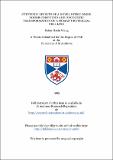Files in this item
Cytotoxic effects of a novel nitric oxide donor compound and oncogenic transformation of a human urothelial cell line
Item metadata
| dc.contributor.advisor | Riches, Andrew Clive | |
| dc.contributor.author | Wang, Hsiao-Hsien | |
| dc.coverage.spatial | 215 p. | en_US |
| dc.date.accessioned | 2018-06-14T15:27:03Z | |
| dc.date.available | 2018-06-14T15:27:03Z | |
| dc.date.issued | 1995 | |
| dc.identifier.uri | https://hdl.handle.net/10023/14088 | |
| dc.description.abstract | Transitional cell carcinoma of the bladder is commonly encountered in urological practice. It affects people of a relatively young age causing economic and social distress to patients. In order to prevent the disease it is important to understand its pathogenesis. In this study, we have tumorigenically transformed a human urothelial cell by growing cells in a serum free, factor free, chemically defined culture. The tumorigenic property of the cell was determined by the generation of a tumor after inoculation into nude mouse. DNA fingerprinting analysis demonstrated the common back ground of the non-tumorigenic human urothelial cell and its tumorigenic transformant. This result also shows evidence of mutation occurring during transformation. By analysing conditioned medium, a significant reduction in the levels of soluble human stem cell factor and interleukin la were found in tumorigenic cell conditioned medium. A model derived from this evidence may suggest that tumor cells undergo further transformation under nutrient and growth factor deprived conditions. Intravesical chemotherapeutic agents in current use have shown moderate tumor-killing effects with some systemic or local side effects. Identification of a drug with better effect and less side effects is essential for the successful treatment of bladder tumors. Nitric oxide (NO) is a natural product of the human body with a role in tumor cell-killing. Thus by using NO as a chemotherapeutic agent we could at least expect limited side effects. Roussin's black salt (RBS) is a novel NO donor. Its cytotoxicity was tested on tumorigenic (T24) and non-tumorigenic (SV-HUC-1) human urothelial cells. The cytotoxicity of RBS was shown to be dose- and contact time- dependent. This cytotoxicity was enhanced by light irradiation and reduced in the presence of haemoglobin. The cytotoxic effect of RBS was also tested on CHO cells and the DNA repair deficient mutant xrs-5 cell line. Both colony forming and micronuclei forming assays demonstrated that xrs-5 cells are more sensitive to RBS than their counterpart. This result may indicate that NO is involved in the cytotoxicity of RBS and furthermore that DNA damage might be one possible mechanism by which the cytotoxic effect of RBS is expressed. | en_US |
| dc.language.iso | en | en_US |
| dc.publisher | University of St Andrews | |
| dc.subject.lcc | QH652.W2 | en |
| dc.subject.lcsh | Radiobiology | en |
| dc.title | Cytotoxic effects of a novel nitric oxide donor compound and oncogenic transformation of a human urothelial cell line | en_US |
| dc.type | Thesis | en_US |
| dc.contributor.sponsor | Ministry of Defence of the Republic of China | en_US |
| dc.type.qualificationlevel | Doctoral | en_US |
| dc.type.qualificationname | PhD Doctor of Philosophy | en_US |
| dc.publisher.institution | The University of St Andrews | en_US |
This item appears in the following Collection(s)
Items in the St Andrews Research Repository are protected by copyright, with all rights reserved, unless otherwise indicated.

